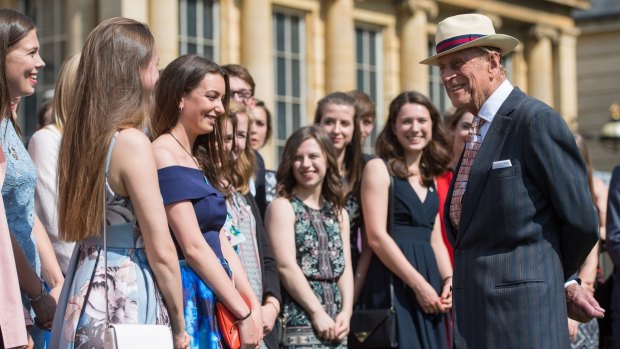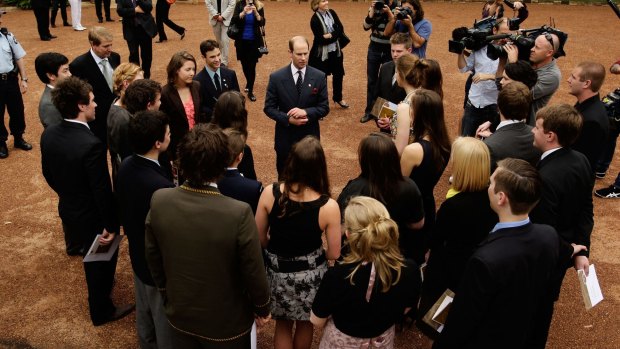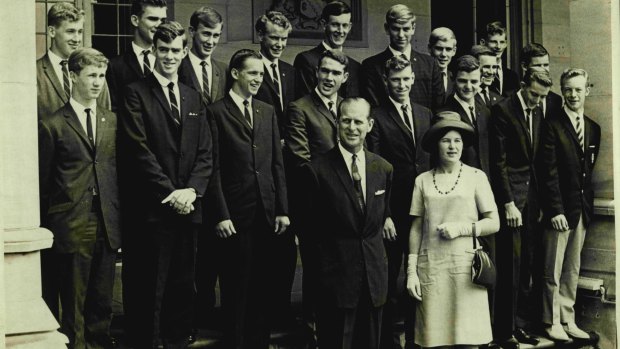This was published 3 years ago
Duke of Edinburgh Awards Scheme: How Prince Philip inspired thousands of young Australian travellers

Prince Philip presents the Duke of Edinburgh's Award to gold level participants at Buckingham Palace in 2017.Credit: Getty Images
To many Australian teenagers, HRH The Duke of Edinburgh Prince Philip , was just a caricature in the Netflix series The Crown, but for generations of others, his Duke of Edinburgh Awards Scheme gave them their first taste of travel and adventure, emerging as one of the British Monarchy's most important legacies.
"Duke of Ed was my first opportunity to get out and explore in such a different way, instead of staying in hotel rooms or poolside at a resort", says Christine Abadier, a school teacher who completed her Bronze and Gold Awards and now supervises Duke of Edinburgh Award participants on hikes.
"It definitely struck my sense of adventure… I went backpacking in Europe when I was 20, which I don't think I would have done without the Duke of Ed."

The Earl of Wessex, Prince Edward talks with Duke of Edinburgh Award recipients at Admiralty House in Sydney in 2009. Close to 800,000 Australians have taken part in the awards over the past 58 years.Credit: Getty Images
Launched in Great Britain in 1956 and established in Australia in 1959, the scheme was never meant to be global, with Prince Philip revealing in a 2016 documentary that they had to "keep up with it" as it grew in popularity. Today 130 countries offer the program, and in Australia close to 800,000 participants have taken part.
The scheme is targeted at young people aged between 14 and 24, involves a Bronze, Silver and Gold Award, and is earned by completing tasks in four areas of self-improvement: physical recreation, skills, volunteering, and undertaking an adventurous journey.
Arguably, the adventurous journey element has always been the most significant part of the scheme, and remains not only the secret to its success, but it's biggest legacy for young Australian travellers.

Prince Philip with award winners in 1965, including Patricia Joy Jeffreys, the first female Australian to receive the award.Credit: Norman Victor Herfort/Fairfax Media
There are three types of adventurous journeys participants can take: an expedition that offers a "journey with a purpose" at bronze level, an exploration that is a "purpose with a journey" at silver level and an "adventurous project" for gold participants.
Put simply, the adventurous journey boils down to getting kids to go bush for the first time.
As a naive 15-year-old with a big mouth and bad attitude, Duke of Ed gave me my first taste of real adventure, taking me out into the wilderness in a way my family had neither the time, inclination or finances to arrange. Some of my best school memories are practising putting up a tent in a school corridor with friends, paddling down a river in the Kangaroo Valley, burning food over a campfire, and mastering the critical skill of the bush wee.
Of course, beyond the memories of burnt marshmallows and soggy socks, we developed real skills in preparation and navigation, teamwork and initiative. But I didn't realise the real impact of the Duke on Ed until I grew up, became a high school teacher, and began accompanying students on their own Duke of Ed expeditions.
Without fail, on every adventurous journey we undertook there were tears, blisters and bruises, leeches and bad weather, and at least one kid who always, always, forgot to pack tent poles: but every time we had fun. Bullies were humbled, wallflowers emboldened, and the playing field levelled as the kids found out they had a lot in common - even if it was just the shared existential teen crisis of being without phone reception for the weekend.
When my old teaching colleagues and I farewelled our "Duke kids" as they finished school, we were quietly delighted to see them post photos of themselves backpacking in Europe and South-East Asia years later, wearing the same battered backpacks they bought new to use on the Duke of Ed hikes with us years before.
While it's easy to be romantic about the Awards Scheme, the Duke wasn't. He frequently alluded to it as a "do-it-yourself growing-up kit", and while often misquoted, in a 2016 documentary commemorating the 60th anniversary of the scheme, he remarked that "Children come into the world completely ignorant with no experience. At least this gives them some idea of what life is like."
Yet despite his flippant remarks, the Duke was proud of the scheme, attending more than 500 Gold Duke of Edinburgh Awards presentations and maintaining an active, hands-on role in the organisation well into his senior years.
Chatting with others who did the Duke of Ed in the days since HRH Prince Philip's death, many recalled how the program not only fed the first seeds of wanderlust, but also their sense of sense of self.
"Growing up raised by a single mother, I never had the chance to go camping or explore the great outdoors with her in that kind of capacity," says Frances Lee.
"I really built grit," says Lee.
"It's helped shape me into a person who is motivated and perseveres through things."
MORE
See also: The hidden history of the royal family's 'Phil the Greek'
Sign up for the Traveller Deals newsletter
Get exclusive travel deals delivered straight to your inbox. Sign up now.